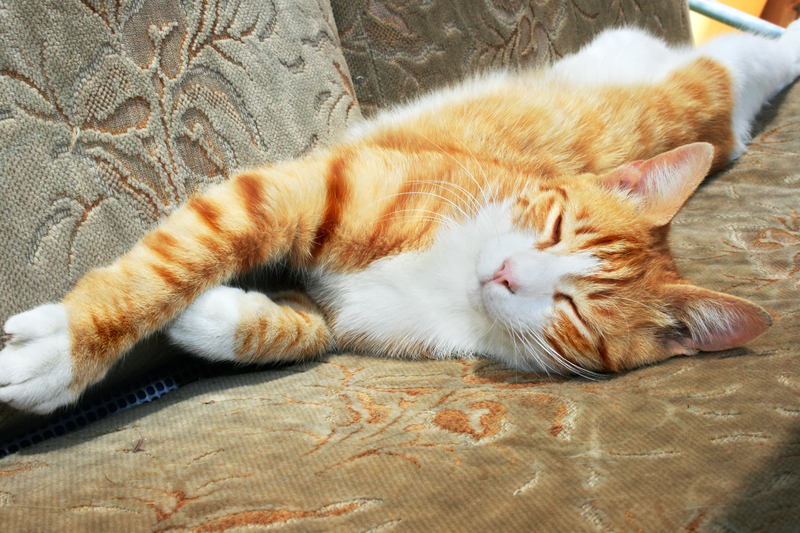Mastering the Wash: Sofa Cover Care to Prevent Damage
Posted on 18/05/2025
Mastering the Wash: Sofa Cover Care to Prevent Damage
Maintaining your sofa covers is essential not only for aesthetic appeal but also for the longevity of your furniture. Learning the best practices for sofa cover care can prevent damage, preserve color, and ensure your living space always looks welcoming. In this comprehensive guide, we reveal the secrets of mastering the wash and preventing costly wear and tear on your cherished sofa covers.
Why Proper Sofa Cover Washing Matters
Sofa covers are more than just decorative elements--they're a protective barrier against spills, dust, pet hair, and daily dirt. Neglecting their upkeep can lead to faded fabrics, unpleasant odors, and even damage to your underlying furniture. Implementing correct washing techniques not only keeps your covers fresh but also extends their lifespan, saving you money and upholding your home's style.
Benefits of Regular and Proper Sofa Cover Care
- Preserves fabric integrity: Prevents premature fraying or weakening.
- Maintains vibrancy: Keeps colors bright and patterns crisp.
- Hygienic: Eliminates allergens, bacteria, and dust mites.
- Odor control: Stops buildup of unpleasant smells.
- Saves money: Reduces frequency of needing replacements or professional cleaning.
- Protects underlying furniture: Prevents stains and damage to the sofa itself.

Understanding Sofa Cover Materials
Before diving into the best washing methods, it's crucial to identify your sofa cover's fabric. Different materials require specific care routines. Let's explore the most common types and their characteristics.
Cotton Sofa Covers
Cotton is a popular choice for slipcovers due to its softness, breathability, and ease of cleaning. While it's durable, cotton can shrink if washed in hot water or dried at high temperatures.
Polyester and Synthetic Blends
Polyester, microfiber, and other synthetics are loved for their resilience and stain resistance. However, high heat, harsh chemicals, or improper agitation can damage the fibers or cause pilling.
Linen Sofa Covers
Linen provides a luxurious, natural texture but may wrinkle and shrink easily. This material often benefits from gentle washing and air drying.
Velvet and Delicate Fabrics
Velvet and similar high-maintenance covers demand special attention. Excess heat or agitation can mar the pile, requiring delicate washing--or even dry cleaning.
Leather or Faux Leather Covers
Unlike fabric covers, leather varieties should never be submerged in water. Instead, clean with specialized wipes or gentle cleansers designed for leather care.
Preparation: Read the Care Label First
The care label attached to your sofa cover is your ultimate guide. Manufacturers provide tailored advice for the specific fabric type, including water temperature, drying methods, and recommended detergents. Always check the label before washing to prevent accidental shrinkage, fading, or deformation.
Step-by-Step Guide: Washing Sofa Covers Safely
1. Pre-treat Stains Immediately
- Address spills and spots as soon as possible for best results.
- Use a mild stain remover or a mix of water and gentle detergent to blot stains, not rub.
- Test any cleaner on a hidden section first to ensure it doesn't discolor or damage the material.
2. Remove the Covers with Care
- Unzip or untuck sofa covers slowly to avoid tearing seams or stressing the fabric.
- Shake covers outdoors to remove loose dust, crumbs, and pet hair.
3. Choosing the Right Washing Method
The ideal washing process depends on your fabric:
- Machine-washable covers: Use a gentle or delicate cycle, cold or lukewarm water, and a mild detergent.
- Hand washing: For extra delicate fabrics, immerse in cool water with a gentle cleanser and softly agitate.
- Dry clean only: If the label says "dry clean only," do not attempt to machine wash or hand wash; seek professional help.
4. Mind the Washing Load
Overloading the washer can cause covers to twist, crease, or wear down. Wash covers one at a time or in pairs, and never mix with rough items like jeans or zippers which may snag the fabric.
5. Drying Your Sofa Covers Properly
- Air drying is always the safest method. Lay covers flat on clean towels or hang over a large drying rack or a sturdy clothesline, ideally out of direct sunlight to prevent fading.
- If using a tumble dryer, opt for a low-heat setting and remove covers while still slightly damp to prevent wrinkles and shrinkage.
- Never wring out covers harshly, as this may misshape the fabric or weaken fibers.
Key Tips for Optimal Sofa Cover Maintenance
Rotate Washing Frequency
Regular but not excessive washing is ideal. For most households, a bi-monthly wash (every two months) keeps covers fresh without accelerating wear. For homes with pets or small children, consider monthly washing.
Use the Right Detergent
- Choose a mild, liquid detergent free of bleach and harsh chemicals.
- For allergy-prone households, select fragrance-free formulas.
- Never use fabric softeners on covers with water-repellent treatments or natural fibers like linen.
Protect from Direct Sunlight
Exposure to the sun can cause fading. Whether drying your furniture covers or placing your sofa in the room, minimize prolonged sun exposure when possible.
Invest in Spare Covers
Buying an extra set of sofa covers allows you to rotate them during cleaning. This decreases the frequency of washing each set, lowers overall wear, and keeps your living space stylish with backup options.
Quick Freshening Between Washes
- Vacuum weekly with a brush attachment to remove dust and hair.
- Spot-clean minor stains using a gentle fabric cleaner or diluted dish soap.
- Deodorize with fabric-safe sprays or a light bicarbonate of soda sprinkle (vacuum up after 15-20 minutes).
Ironing and Re-fitting
If your covers look wrinkled after drying, iron them on the lowest setting recommended for the fabric. Refit covers while they're still slightly damp for a snug, crease-free appearance.
Troubleshooting: Common Sofa Cover Washing Mistakes
- Shrinking: Prevent by always washing in cold or lukewarm water and air-drying or using a low-heat tumble dry setting.
- Color bleeding: Wash new covers separately for the first few washes; use color-catcher sheets if needed.
- Fabric puckering or wrinkling: Never overload the washing machine or use high agitation. Iron or steam covers gently after washing.
- Persistent stains: Pre-treat thoroughly before washing, and use a fabric-appropriate stain remover.
The Don'ts: What to Avoid in Sofa Cover Care
- Don't use bleach or caustic stain removers--these weaken fibers and fade colors.
- Don't dry at high temperatures as this can shrink or warp fabrics.
- Don't wring or twist covers harshly--press water out gently instead.
- Don't ignore the care label. It provides vital washing and drying instructions for your specific fabric.
Professional Sofa Cover Cleaning: When Is It Necessary?
While most removable covers can be washed at home, there are occasions when professional cleaning is a safer bet:
- Heavily stained or soiled covers that can't be restored with regular detergent.
- Materials marked "dry clean only."
- Delicate or custom fabrics, such as silk, embroidered, or velvet slipcovers.
- If covers are attached (non-removable) and require in-situ cleaning.
Tip: Always communicate the nature of spills or stains to your cleaning service, especially if dealing with wine, ink, or oil.
Long-Term Sofa Care: Prevention Is Better Than Cure
Incorporating protective habits into your daily life can prolong the beauty and durability of your sofa covers. Here's how:
- Ban eating messy foods on the sofa to reduce risk of stains.
- Enforce pet rules or use designated pet throws to limit fur and claw damage.
- Encourage everyone to use clean hands and avoid sitting with dirty clothes on upholstered furniture.
- Vacuum the couch and covers weekly to stop dust and grit from embedding in fibers.

Frequently Asked Questions About Sofa Cover Care
Can I wash all types of sofa covers in a washing machine?
No. While many cotton and synthetic covers are machine-washable, always check the care label. Delicate materials or those labeled "dry clean only" should not be machine washed.
How do I avoid shrinkage?
Wash with cold or lukewarm water, avoid high heat in the dryer, and always follow the manufacturer's instructions to minimize risk of shrinkage.
What's the best way to tackle stubborn stains?
Pre-treat stains with a fabric-appropriate stain remover and let it sit for 10-20 minutes before washing. For oil or grease, sprinkle a little baking soda to absorb first.
Do I need to iron my sofa covers?
For a crisp look, you may iron covers using the recommended heat setting for your fabric, or fit them onto your sofa while slightly damp to avoid creasing.
Is it safe to use bleach on white sofa covers?
Generally, bleach should be avoided as it can weaken fibers and cause yellowing. Opt for oxygen-based bleach if necessary, but spot-test first and follow fabric guidelines.
Conclusion: Achieving Mastery in Sofa Cover Care
Mastering the wash and caring for your sofa covers doesn't require complicated routines--just attention to fabric, proper washing techniques, and preventative measures. By understanding your covers' unique needs and respecting their cleaning guidelines, you can preserve their beauty, comfort, and durability for years to come.
With these sofa cover washing tips, you'll not only prevent damage but also create a healthier, more inviting living space. Don't underestimate the power of informed, consistent care--your furniture (and your wallet) will thank you!




